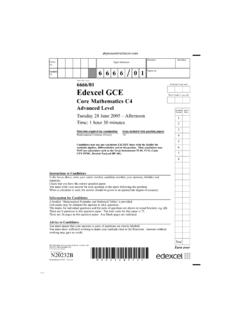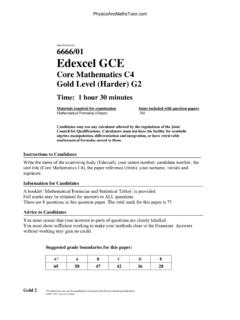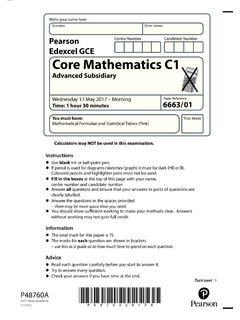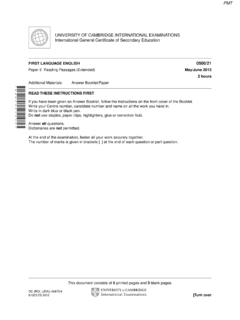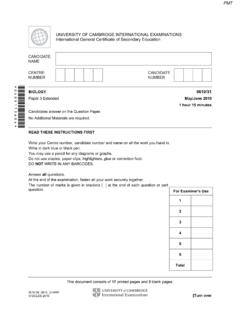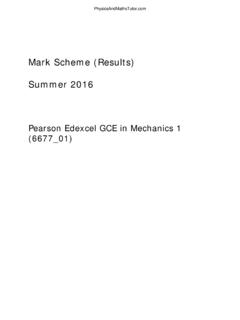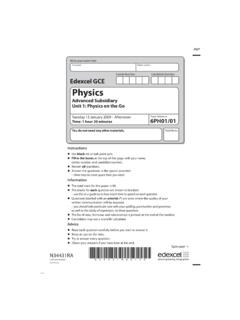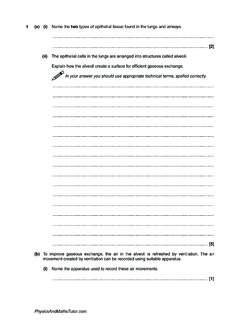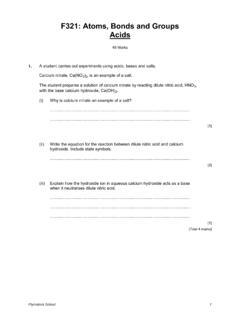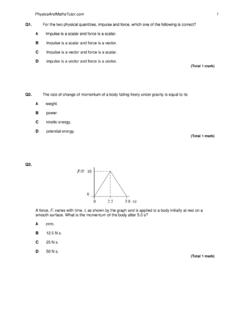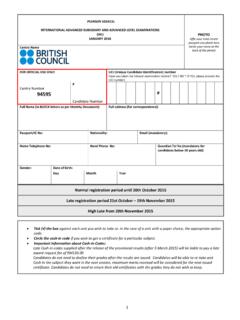Transcription of Mark Scheme (Standardisation) January 2010
1 Mark Scheme ( standardisation ) January 2010 GCE GCE Physics (6PH07/1) edexcel Limited. Registered in England and Wales No. 4496 50 7 Registered Office: One90 High Holborn, london WC1V 7BH PMTG eneral Marking Guidance All candidates must receive the same treatment. Examiners must mark the first candidate in exactly the same way as they mark the last. Mark schemes should be applied positively. Candidates must be rewarded for what they have shown they can do rather than penalised for omissions. Examiners should mark according to the mark Scheme not according to their perception of where the grade boundaries may lie.
2 There is no ceiling on achievement. All marks on the mark Scheme should be used appropriately. All the marks on the mark Scheme are designed to be awarded. Examiners should always award full marks if deserved, if the answer matches the mark Scheme . Examiners should also be prepared to award zero marks if the candidate s response is not worthy of credit according to the mark Scheme . Where some judgement is required, mark schemes will provide the principles by which marks will be awarded and exemplification may be limited.
3 When examiners are in doubt regarding the application of the mark Scheme to a candidate s response, the team leader must be consulted. Crossed out work should be marked UNLESS the candidate has replaced it with an alternative response. PMTMark Scheme notes Underlying principle The mark Scheme will clearly indicate the concept that is being rewarded, backed up by examples. It is not a set of model answers. For example: (iii) Horizontal force of hinge on table top (N) or 66 (N) and correct indication of direction [no ue] [Some examples of direction: acting from right (to left) / to the left / West / opposite direction to horizontal.]
4 May show direction by arrow. Do not accept a minus sign in front of number as direction.] 9 1 This has a clear statement of the principle for awarding the mark, supported by some examples illustrating acceptable boundaries. 1. Mark Scheme format You will not see wtte (words to that effect). Alternative correct wording should be credited in every answer unless the ms has specified specific words that must be present. Such words will be indicated by underlining resonance Bold lower case will be used for emphasis. Round brackets ( ) indicate words that are not essential (hence) distance is increased.
5 Square brackets [ ] indicate advice to examiners or examples [Do not accept gravity] [ecf]. 2. Unit error penalties A separate mark is not usually given for a unit but a missing or incorrect unit will normally cause the final calculation mark to be lost. Incorrect use of case Watt or w will not be penalised. There will be no unit penalty applied in show that questions or in any other question where the units to be used have been given. The same missing or incorrect unit will not be penalised more than once within one question but may be penalised again in another question.
6 Occasionally, it may be decided not to penalise a missing or incorrect unit the candidate may be calculating the gradient of a graph, resulting in a unit that is not one that should be known and is complex. The mark Scheme will indicate if no unit error penalty is to be applied by means of [no ue]. 3. Significant figures Use of an inappropriate number of significant figures in the theory papers will normally only be penalised in show that questions where use of too few significant figures has resulted in the candidate not demonstrating the validity of the given answer.
7 Use of an inappropriate number of significant figures will normally be penalised in the practical examinations or coursework. Using g = 10 m s 2 will not be penalised. 4. Calculations Bald ( no working shown) correct answers score full marks unless in a show that question. If a show that question is worth 2 marks then both marks will be available for a reverse working; if it is worth 3 marks then only 2 will be available. use of the formula means that the candidate demonstrates substitution of physically correct values, although there may be conversion errors power of 10 error.
8 Recall of the correct formula will be awarded when the formula is seen or implied by substitution. The mark Scheme will show a correctly worked answer for illustration only. Example of mark Scheme for a calculation: Show that calculation of weight PMT Use of L W H Substitution into density equation with a volume and density Correct answer [ (N)] to at least 3 sig fig. [No ue] [Allow (N) for answer if 10 N/kg used for g.] [If 5040 g rounded to 5000 g or 5 kg, do not give 3rd mark; if conversion to kg is omitted and then answer fudged, do not give 3rd mark] [Bald answer scores 0, reverse calculation 2/3] Example of answer: 80 cm 50 cm cm = 7200 cm3 7200 cm3 g cm-3 = 5040 g 5040 10-3 kg N/kg = N 9 9 9 3 5.
9 Quality of Written Communication Indicated by QoWC in mark Scheme , placed as first mark. Usually it is part of a max mark. 6. Graphs A mark given for axes requires both axes to be labelled with quantities and units, and drawn the correct way round. Sometimes a separate mark will be given for units or for each axis if the units are complex. This will be indicated on the mark Scheme . A mark given for choosing a scale requires that the chosen scale allows all points to be plotted, spreads plotted points over more than half of each axis and is not an awkward scale multiples of 3, 7 etc.
10 Points should be plotted to within 1 mm. Check the two points furthest from the best line. If both OK award mark. If either is 2 mm out do not award mark. If both are 1 mm out do not award mark. If either is 1 mm out then check another two and award mark if both of these OK, otherwise no mark. For a line mark there must be a thin continuous line which is the best-fit line for the candidate s results. Qu ties on Nue mb r Answ erMark 1. C 1 2 ( D a)1 (b)B 1 (c)A 1 3. D 1 Total 5 Question Answer Mark PMT Number 4(a) [ marks can be from text or diagram] Max 3 from Means of measuring height (1) Means of determining speed (1) Equates (final) GPE with (final) KE (1) Method to determine KE after bounce (1) Description of appropriate experimental method (1) States that mass cancels OR mass stays the same OR mass measured OR mass known (1) Indication of how (percentage) energy loss will be determined (1) States sensible precaution (1)
